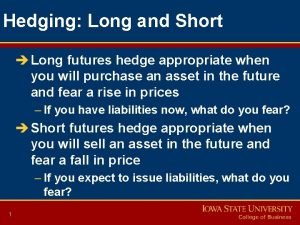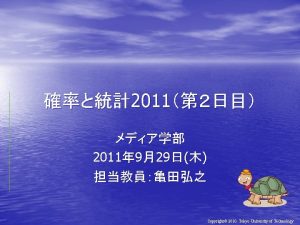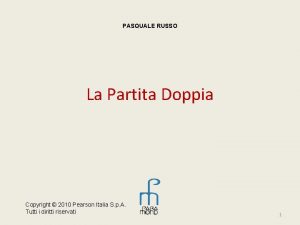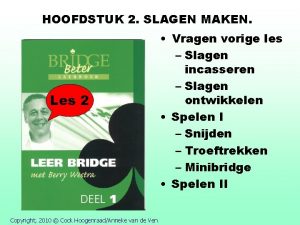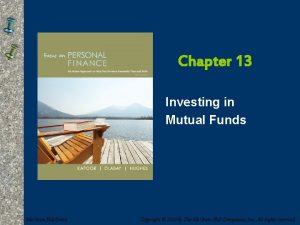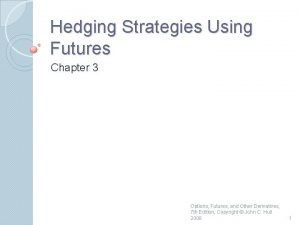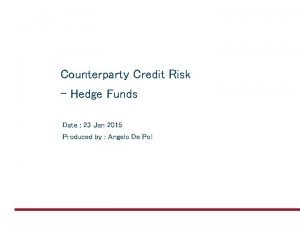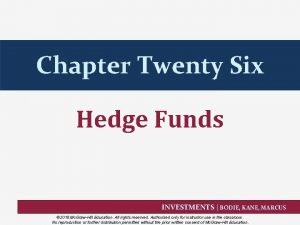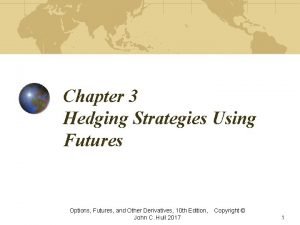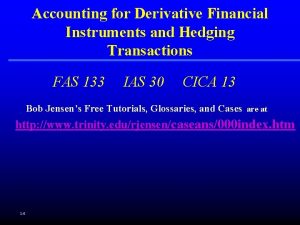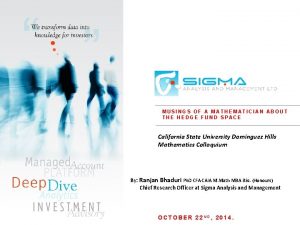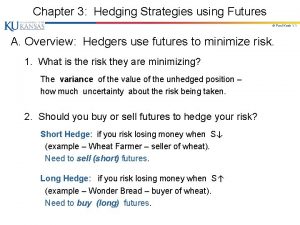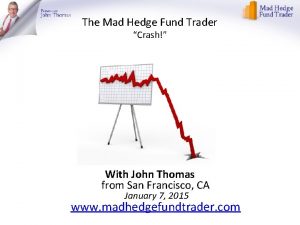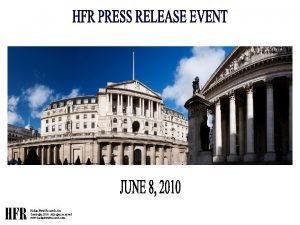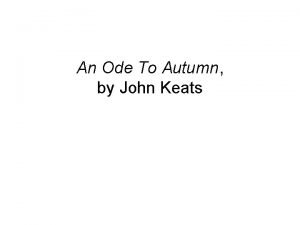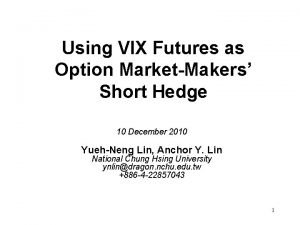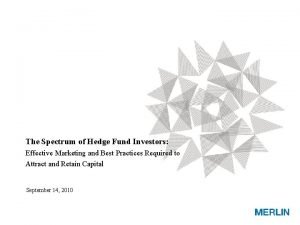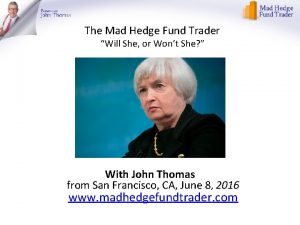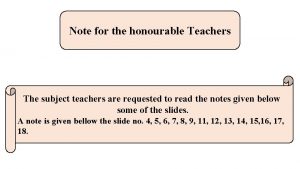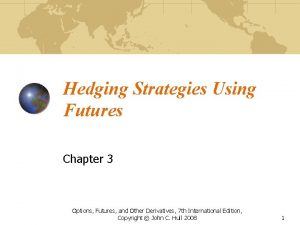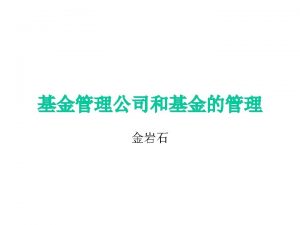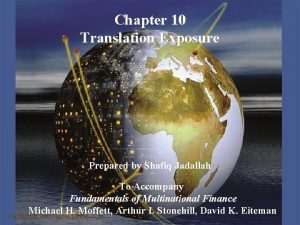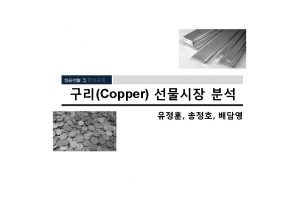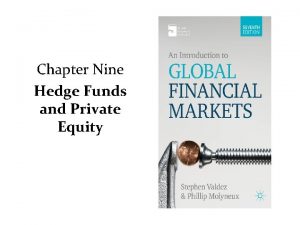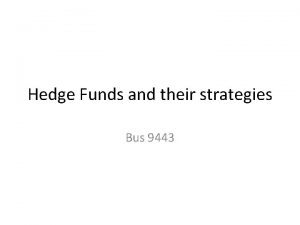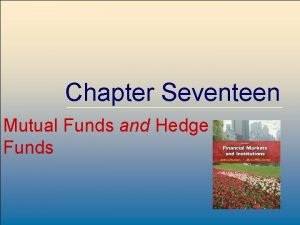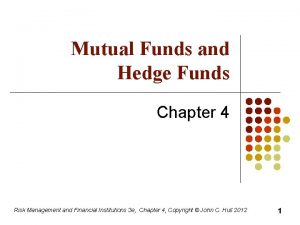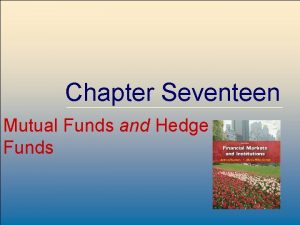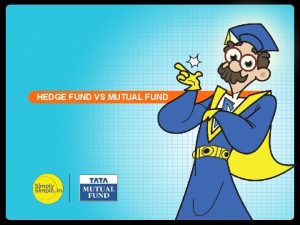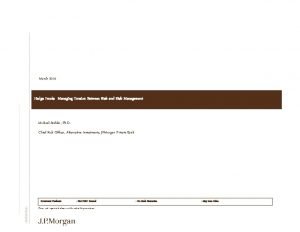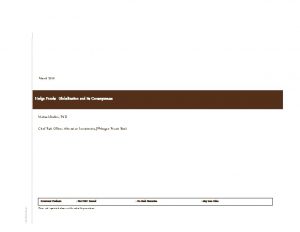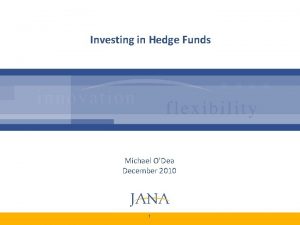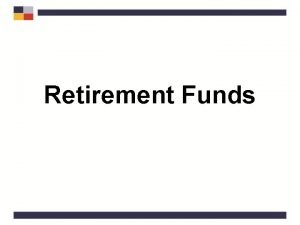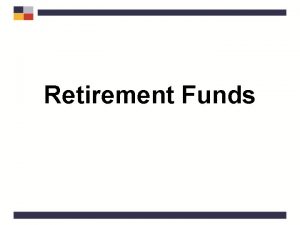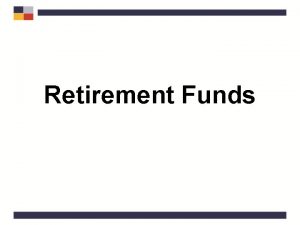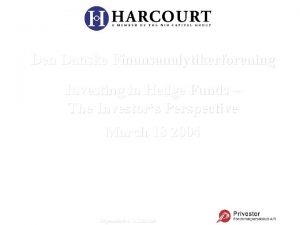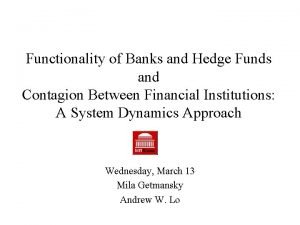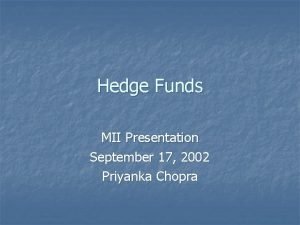Chapter 20 Hedge Funds Mc GrawHillIrwin Copyright 2010








































- Slides: 40

Chapter 20 Hedge Funds Mc. Graw-Hill/Irwin Copyright © 2010 by The Mc. Graw-Hill Companies, Inc. All rights reserved.

20. 1 Hedge Funds Versus Mutual Funds 20 -2

Hedge Funds vs Mutual Funds Transparency Investors Strategies Mutual Funds Hedge Funds • Public info on portfolio composition • Info provided only to investors • Unlimited • < 100, high dollar minimums • Must adhere to prospectus, limited short selling & leverage, limited derivatives usage • No limitations 20 -3

Hedge Funds vs Mutual Funds Liquidity Fees Hedge Funds • Multiple year lock • Redeem up periods typical shares on demand • Fixed percentage • Fixed of assets; typically percentage of 1% to 2% plus assets; incentive fee = typically 0. 5% 20% of gains to 2% above threshold return 20 -4

20. 2 Hedge Fund Strategies 20 -5

Directional & Non-Directional Strategies • Directional strategies – A position that benefits if one sector of the market outperforms another, an unhedged bet on a price movement – For example, buy bonds in anticipation of an interest rate decline 20 -6

Directional & Non-Directional Strategies • Non-Directional strategies – Attempt to arbitrage a perceived mispricing • Typically a risky arbitrage • For example, spread between corporates and Treasuries is believed to be too large so you buy the corporates and short the Treasuries. • Market neutral with respect to overall interest rates. • Which type of strategy is riskier, Directional or Non-Directional? 20 -7

Hedge Fund Styles Insert Table 20. 1 here 20 -8

Convertible Bond Arbitrage • Convertible bond arbitrage: – If the fund thinks the convertible is underpriced the fund would buy the convertible and short the stock. Wait for the mispricing to be fixed. • Risky strategies, bets on particular perceived mispricings, called “pure play” bets 20 -9

Statistical Arbitrage • Statistical arbitrage – Uses quantitative math models and often automated trading strategies that attempt to identify small mispricings in multiple securities. – Involves placing small bets in hundreds of different securities for short holding periods (minutes). – Require fast trading and low transactions costs. – “Pairs Trading” • Find two ‘twin’ stocks; short the high priced one and buy the low priced one. • Do this for many pairs, rely on law of large numbers. 20 -10

20. 3 Portable Alpha 20 -11

Fundamental risk and mispriced securities • Problem: – A fund finds a positive alpha stock but expects the overall market to fall. • Solution: – Buy the stock and sell stock index futures to drive effective stock beta to zero, – This is a ‘market neutral’ pure play, – When combined with a passive strategy this is called alpha transfer. 20 -12

Pure Play Example Find a portfolio with P > 0, but r. M < 0 The portfolio monthly return is We wish to hedge by selling stock index futures. How many contracts should we sell if we have a $1, 000 portfolio? Dollar value of the stock portfolio in one month will be: 20 -13

Pure Play Example Futures Position Value = 6 x 250 x (F 0 -F 1) F 0 = 1. 01 S 0 from spot futures parity model, F 1 = S 1 because of convergence of spot and futures prices at contract maturity, substituting into the Future’s Position Value formula: 6 x 250 x (1. 01 S 0 – S 1) S 1 = S 0(1+r. M) ; The market moves by r. M so we now have: 6 x 250 x (1. 01 S 0 – S 0(1+r. M)) 1500 x (800(. 01 -r. M) = $12, 000 - $1, 200, 000 r. M Spot futures position combined: = 1500 x (S 0(. 01 -r. M)); recall S 0 = 800 so 20 -14

Pure Play Example We have captured the alpha and hedged out the market risk. (Unsystematic risk remains. ) 20 -15

Pure Play Example 20 -16

20. 4 Style Analysis for Hedge Funds 20 -17

Style and Factor Loadings • Many fund strategies are directional bets and may be evaluated with style analysis (see Chapter 18), • Directional investments will have nonzero betas, called “factor loadings, ” • Typical factors may include exposure to stock markets, interest rates, credit conditions and foreign exchange. 20 -18

Style Analysis w/ Hedge Funds 20 -19

20. 5 Performance Measurement for Hedge Funds 20 -20

Fund Alphas and Sharpe Ratios • Hasanhodzic and Lo (2007) find that style adjusted alphas and Sharpe ratios are significantly greater than the measures for the S&P 500 for a large sample of hedge funds. • This implies: – Hedge fund managers are highly skilled OR – Aragon (2007) controls for illiquidity of hedge funds with lockup periods and other redemption restrictions and finds the alphas become insignificant. – Related work by Sadka (2008) shows that hedge funds must generate significantly larger returns to offset liquidity risk. 20 -21

Illiquidity and Hedge Fund Performance Prices in illiquid markets tend to exhibit serial correlation. – In illiquid markets funds estimate values of their investments to calculate the fund’s share values and rates of return to quote to investors, • Funds estimate prices optimistically, • Funds mark to market slowly instead of all at once, • Serial correlation is strongly related to fund’s Sharpe ratios. What does this imply? – Higher Sharpe ratios are compensation for illiquidity • The Santa effect: – Hedge funds typically report results in December and average returns are highest in December. 20 -22

Serial Correlation and Sharpe Ratios of Hedge Funds 20 -23

Fund Performance and Survivorship Bias • Survivorship bias is a problem in performance measurement of risky hedge funds – Those that don’t survive don’t report results that are used in estimating average performance. • Backfill bias – Hedge funds report returns to publishers only if they choose to. 20 -24

Fund Performance & Factor Loadings • Many performance measures assume constant risk levels and many hedge funds have variable risk levels. – This implies that the positive alphas may be due to measurement error. • Many funds hold options or perform like options – Option positions make performance measurement more challenging because options result in nonlinear performance but most performance measures assume or fit a straight line to return data. 20 -25

Characteristic Line of a Timer 20 -26

Characteristic Line of a Stock Portfolio with Written Options 20 -27

Returns on Broad Hedge Fund Index vs S&P 500, 1993 -2008 20 -28

Returns on Fixed-Income Arbitrage Funds vs S&P 500, 1993 -2008 20 -29

Returns on Event-Driven Funds vs S&P 500, 1993 -2008 20 -30

Tail Events and Performance • Many hedge funds employ mathematical models that rely on near term historical price data. • Their strategies’ performance takes the form of a written put option. – Writing a put option is a way to capture the put premium and is appropriate in low volatility markets. – In high volatility markets they face large losses, out of pocket if markets fall and large opportunity costs if markets rise. • When the more rare large market moves (tail events) do occur hedge fund performance is not likely to appear as strong and they may suffer large losses. 20 -31

20. 6 Fee Structure in Hedge Funds 20 -32

Evaluating Hedge Fund Fees • Typical hedge fund fees includes a fixed management fee between 1% and 2% of assets plus an incentive fee usually equal to 20% or more of investment profits above a benchmark performance return. • Incentive fees are analogous to call options on the portfolio with a strike price equal to the current portfolio value x (1+ benchmark return). 20 -33

Incentive Fees as a Call Option 20 -34

Black-Scholes Value of Incentive Fee • • Suppose a hedge fund’s returns have an annual =30% The annual incentive fee is 20% of the return over the risk free money market rate. The fund has a net asset value of $100 per share and the annual risk free rate is 5%. The implicit exercise price of the incentive fee is $100 x 1. 05 = $105 The Black-Scholes value of a call option with S 0 = $100, X = $105, =30% , T = 1 year, & rf = LN 1. 05 = 4. 88% is $11. 92. (See Chapter 16 for details on option prices) Incentive fee is equal to only 20% of the value over $105 so the current value of the incentive fee = 20% x $11. 92 = $2. 38 per share or 2. 38% of net asset value. Coupled with 2% management fee yields total fees of 4. 38%, much larger than mutual funds. 20 -35

Fees and the High Water Mark • High Water Mark – Funds that experience losses in one period may not be able to charge any incentive fee until the prior period losses are regained. – This complicates estimating the value of the incentive. – Gives managers an incentive to close the fund and start over when large losses occur. 20 -36

Funds of Funds • Funds of funds invest in one or more other hedge funds. – Serve as ‘feeder funds’ to ultimate hedge fund – Allows investors to easily diversify across hedge funds. – May be a bad deal because of extra layer of fees. – Earned a bad reputation when it became apparent that many large fund of funds were major investors in Bernard Madoff’s $50 billion Ponzi scheme. 20 -37

Fees and Funds of Funds • Suppose a fund of funds has $1 million invested in each of three hedge funds. For simplicity assume the hurdle rate to earn incentive fees is a zero rate of return (no losses) and the normal fixed asset management fee is zero. Fund 1 Start of year (M$) $1. 00 End of year (M$) $1. 20 Gross rate of return 20% Incentive fee (M$) $0. 04 End of year value, net of fee $1. 16 Net rate of return 16% • • Fund 2 $1. 00 $1. 40 40% $0. 08 $1. 32 32% Fund of Fund 3 Funds $1. 00 $3. 00 $0. 25 $2. 85 -75% -5% $0 $0. 12 $0. 25 -75% $2. 73 -9% The fund of funds must pay incentive fees even though it realized a net loss. The fund of funds normally charges a lower incentive fee to its own investors, but still another layer of fees. 20 -38

The $50 Billion Madoff Scandal • Madoff operated a $50 billion Ponzi Scheme – In a Ponzi scheme the con artist (Madoff) promises and initially pays high returns to investors. The large returns are generated by paying out to old clients some of the money paid in by new clients. • The con also skims some of the money for his or her own purposes. The scheme can work for some time until the fund stops growing. • Madoff was a respected individual, former chairman of NASDAQ with prestigious client book. 20 -39

The $50 Billion Madoff Scandal • In 2008 redemptions began as clients needed money, scheme unwound. • Lack of reporting requirements made the fraud possible but there were several warning signs: – Returns were too stable for too long, – Fund fee structure was too generous, – Audit firm was not a major auditor, – All assets were kept in house rather than with a custodian, – No evidence of option investments Madoff claimed to be making, – SEC received a letter in 2000 stating that the fund was a Ponzi scheme. 20 -40
 Short futures hedge
Short futures hedge Forward exposure
Forward exposure 2010 pearson education inc
2010 pearson education inc Copyright 2010
Copyright 2010 Variazioni finanziarie attive e passive
Variazioni finanziarie attive e passive Copyright 2010 pearson education inc
Copyright 2010 pearson education inc Copyright 2010 pearson education inc
Copyright 2010 pearson education inc Copyright 2010
Copyright 2010 Nwoz
Nwoz Copyright 2010 pearson education inc
Copyright 2010 pearson education inc Copyright 2010 pearson education inc
Copyright 2010 pearson education inc Copyright 2010 pearson education inc
Copyright 2010 pearson education inc 2010 pearson education inc
2010 pearson education inc Copyright 2010 pearson education inc
Copyright 2010 pearson education inc Copyright 2010 pearson education inc
Copyright 2010 pearson education inc Pearson education inc all rights reserved
Pearson education inc all rights reserved Chapter 13 investing in mutual funds
Chapter 13 investing in mutual funds Mad hedge fund trader
Mad hedge fund trader Hedge ratio formula
Hedge ratio formula Hedge fund credit risk
Hedge fund credit risk Hedge fund high water mark
Hedge fund high water mark Hedge ratio formula
Hedge ratio formula Hedge ratio formula
Hedge ratio formula Hedge ratio
Hedge ratio Hedge statement
Hedge statement Accounting for derivative instruments
Accounting for derivative instruments Mad hedge fund trader
Mad hedge fund trader Hedge fund math
Hedge fund math Tailing the hedge
Tailing the hedge Mad hedge fund trader
Mad hedge fund trader John thomas mad hedge fund
John thomas mad hedge fund Hedge fund research inc
Hedge fund research inc Hedge crickets sing and now with treble soft
Hedge crickets sing and now with treble soft Using vix to hedge
Using vix to hedge Effective hedge fund marketing
Effective hedge fund marketing Mad hedge fund trader
Mad hedge fund trader Hedge meaning
Hedge meaning Hedging strategies using futures and options
Hedging strategies using futures and options Mark dickstein hedge fund
Mark dickstein hedge fund Transaction exposure and economic exposure
Transaction exposure and economic exposure Translation exposure arises
Translation exposure arises
